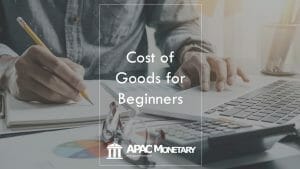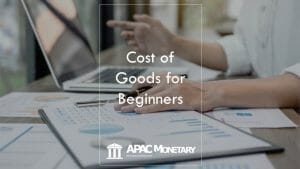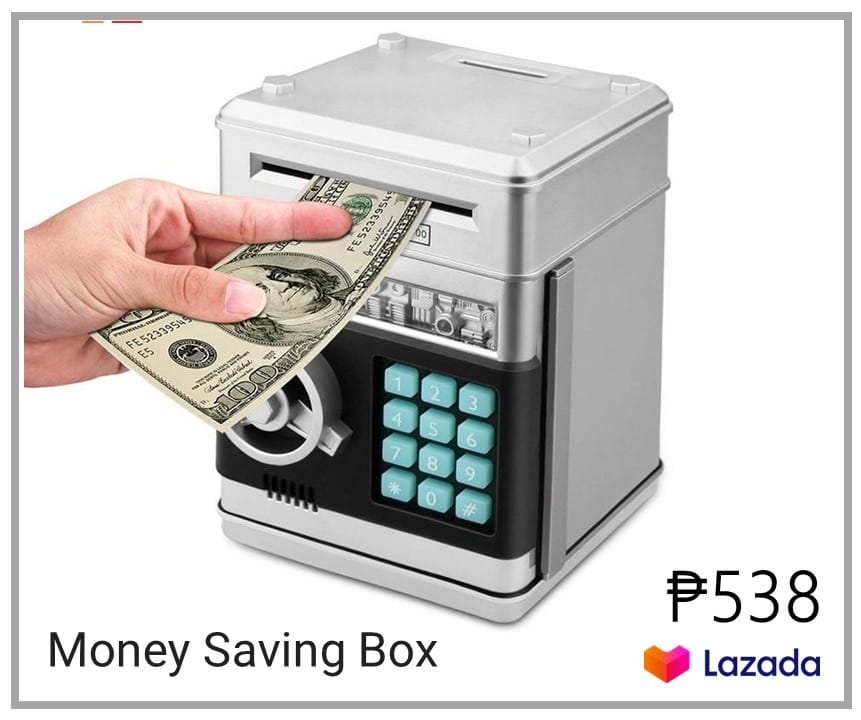Table of Contents
The “Cost of Goods Sold” is a very important accounting concept. What is the Cost of Goods Sold? How to calculate the cost of goods sold? Learn more about the cost of goods sold. Understand how to calculate it and how to use it. Read our ultimate guide to COGS for beginners!
When you are running a business, one of the most important things to track is your cost of goods sold. This is how much money you have spent on all of your products and services. In this article, we will discuss what the cost of goods sold in accounting and finance, the formula, and how to calculate COGS.

What Is The Cost Of Goods Sold?
The cost of goods sold is the sum of the costs of materials, labor, and overhead incurred in creating or producing a product. This figure is important because it helps businesses budget for their expenses and tracks their financial performance.
For businesses, managing the cost of goods sold is critical to profitability. Low costs can indicate that a company is producing products at a lower price point than its competition. In contrast, high costs can indicate that a company is overspending on production or using expensive materials. In either case, managing costs can help a business improve its bottom line.
Costs associated with production vary based on the product being made. For example, for clothing companies, costs might include materials such as cotton and wool fibers, dyes, and sewing machines. For industrial products such as airplanes and automobiles, higher-cost items might include machinery and parts sourced from overseas. Regardless of the product’s specifics, tracking all relevant expenses helps businesses make informed decisions about how to best allocate resources and reduce costs.
Underlying expenses are those costs associated with producing a product, such as raw materials and wages. This figure is divided among the items that are produced in order to calculate the COGS. The sum of these expenses is known as the “normal balance of the cost of goods sold.” In most cases, if this figure falls below zero, it signals that a company is overproducing and may need to reduce its production or prices. Conversely, if the normal balance exceeds your company’s actual costs, this indicates that you’re producing too little and could benefit from increasing your output.
There are a few key factors to consider when tracking the cost of goods sold:
1. Subtotal
The first step in calculating the cost of goods sold is totaling all the expenses associated with producing the product.
2. Unit Costs
Next, divide each expense by the number of units produced. This will give you a “unit cost” for that particular item.
3. Production Costs
Finally, add together unit costs from all items produced. This will give you your production costs.
4. Normal Balance of Cost of Goods Sold
The final figure is the sum of production costs minus the subtotal (assuming all expenses were incurred during the production stage). This number is often referred to as the “normal balance of the cost of goods sold.”
Keep in mind that this number should reflect actual costs incurred during production, not those incurred after products have been shipped to retailers or customers. For example, suppose shipping costs are included in the normal balance of the COGS. In that case, it may be misleading to report a company’s production costs as only including expenses related to manufacturing.

How To Calculate The Cost Of Goods Sold?
The cost of goods sold is the cost of items that a business sells, including the cost of materials, labor, and overhead. To calculate the cost of goods sold, businesses first need to know their total costs. They then subtract any discounts or rebates they’ve received from suppliers. The result is the amount that the business has actually spent on the items it’s sold.

The COGS formula is:
Cost of goods sold = Production costs + Subtotal (of discounts and rebates)
There are a few things to remember when working with the cost of goods sold formula. First, it’s important to remember that the subtotal of discounts and rebates should only include items that were actually purchased by the business. For example, if a company sells products for $100 each but has received a $10 discount from its supplier, the subtotal of discounts and rebates should only be $90.
Second, it’s important to keep track of how much money is being spent on each item. If a company sells 200 widgets for $10 each but spends $2,000 on materials and labor, the cost of goods sold would be $20 per widget.
And finally, it’s important to ensure that all costs are properly recorded. For example, if a company spends $5,000 on marketing but doesn’t include that cost in its subtotal of discounts and rebates, it will have an incorrect COGS sold figure.

Common Mistakes When Calculating The COGS
When calculating the cost of goods sold, businesses often make common mistakes. Here are four of the most common:
1. Not Calculating Inventory On A Full Cycle:
Often, businesses will not calculate inventory on a full cycle. This means that they will not account for items that have been sold and then returned to the inventory. This can lead to an inaccurate calculation of the cost of goods sold.
2. Failing To Track Vendor Payments:
Many businesses do not track vendor payments accurately. If a vendor does not receive payment on time, this can affect their inventory levels and ultimately lead to an inaccurate calculation of the cost of goods sold.
3. Ignoring Changes In Inventory Levels:
It is important to track changes in inventory levels so that you can accurately calculate your cost of goods sold. If your inventory levels go down, this will affect your costs; if your inventory levels go up, this will affect your profit margins accordingly.
4. Not Taking Into Account Implicit Costs Associated With Manufacturing And Distribution:
Many businesses unfairly ignore implicit costs associated with manufacturing and distribution when calculating the cost of goods sold (such as employee wages). By doing so, they can underestimate their actual costs.

Examples Of COGS In Businesses
The cost of goods sold (COGS) is the sum of all costs associated with producing and selling a good or service. These costs can include direct costs such as salaries, materials, and utilities; indirect costs such as factory overheads; and marketing expenses.
The main aim of COGS is to ensure that a company’s revenue matches its expenses. To calculate COGS, businesses typically divide total revenue by the total COGS. This provides an indication of how profitable the company has been about its overall operating budget.
There are several factors that can affect COGS. For example, if the company experiences high levels of inflation, its costs will rise faster than its revenue, resulting in a negative COGS figure. Conversely, if the company experiences low levels of inflation, its costs will fall faster than its revenue, resulting in a positive COGS figure.
How Does the COGS Formula Affect Your Taxes?
The cost of goods sold (COGS) is a fundamental financial metric used by businesses to track, manage and report their costs associated with producing and selling goods. The COGS formula accounts for the total cost of all materials and labor used in the production of a product or service.
To calculate COGS, businesses must first identify the costs of their raw materials, direct labor, and other operating expenses. Next, they must divide each expense by the number of units produced to arrive at a cost per unit. Finally, they must multiply this cost per unit by the total number of units produced to determine COGS.
The COGS calculation is important for tax purposes because it can affect how much money a business pays in taxes on its profits.
For example, if a business produces widgets that have a COGS of $10 per unit, but its taxable income is only $8 per widget due to low margins, then it would owe taxes on $2 worth of profits ($10 ÷ $8 = 2).
If, however, the business’s COGS was higher—say $12 per unit—then it would only owe taxes on $1 worth of profits ($10 ÷ $12 = 1.2).
Thus, it is important for businesses to track their COGS closely to ensure they are paying the right amount of taxes.

What Are The Benefits Of Tracking Your COGS?
There are several benefits to tracking your cost of goods sold. Knowing your costs allows you to make better decisions about where to allocate your resources and can help you identify areas where you may be overspending.
Tracking your COGS can also help you optimize your production processes. By understanding how many raw materials and labor it takes to produce a product, you can find ways to economize in both areas. This can lead to increased profitability and shareholder value.
Finally, tracking COGS can give you an overview of how your business is performing overall. By understanding where expenses are being spent, you can identify opportunities for cost savings or revenue expansion. All in all, tracking COGS is an important tool for any company looking to improve its bottom line.

Tips For Increasing Your Cost Of Goods Sold!
There are a few tips that can help you increase your cost of goods sold.
First, make sure that the products you sell are of high quality. Poor quality products will lead to higher costs in the long run, as customers will be more likely to return them and less likely to recommend your business to others.
Additionally, make sure that your inventory is managed efficiently. Overstock and excess inventory can lead to increased costs related to storage, transportation, and disposal; by keeping your inventory under control, you can reduce these costs overall.
Finally, consider pricing your products appropriately. Too low a price may mean that customers don’t feel like they’re getting a good deal, while too high a price may limit the number of sales you can generate overall.
By using these tips, you can increase your COGS and ensure that your business remains profitable long term!

What is The Cost of Goods Sold: Common Types of COGS
The cost of goods sold is the sum of all costs associated with the production or distribution of a product. These include materials, labor, and overhead expenses.
1. Materials: What is the cost of goods sold in relation to materials?
The cost of goods sold includes the cost of materials used in the production process and any associated costs such as depreciation or obsolescence. Materials can be expensive to purchase and require significant expenditures to maintain, making them a vital part of a business’s cost structure.

2. Labor: What is the cost of goods sold in relation to labor?
Labor is a high cost in the production of goods and services. The cost of goods sold (COGS) measures the dollar amount of costs associated with the production of a good or service, including direct materials, direct labor, and indirect labor. Labor costs can be broken down into employee compensation (wages and salaries), benefits, occupancy costs (primarily rent and utilities), transportation costs, etc. The overall COGS cost for a product can be different depending on the stage in the production process it is located in. For example, early-stage products may have higher COGS due to more expensive employee compensation, while later-stage products may have lower COGS due to lower occupancy costs.
3. Overhead: What is the cost of goods sold in relation to overhead?
Overhead costs are a major component of most businesses. Overhead costs can include salaries, benefits, rent, and other expenses associated with running a business. The cost of goods sold (COGS) is a key measure of profitability for businesses. COGS measures how much money a company makes after subtracting the COGS from the total revenue.
The cost of goods sold is important because it tells us how much money a business makes from its products. The higher the COGS, the better the company’s overall performance. However, several factors can affect COGS figures. For example, if a company’s products are expensive to produce, then its COGS will be high. Conversely, if a company produces low-cost products, its COGS will be low.
Overall, overhead costs can significantly impact a business’s profitability. It’s important to keep track of these costs to make informed decisions about running your business.”

4. Transportation Costs: What is the cost of goods sold in relation to transportation costs?
The cost of goods sold includes all costs associated with producing and distributing a product. To calculate the COGS, it is necessary to include the costs incurred in the following categories: materials, labor, overhead expenses, and profit. The three most common transportation costs are freight (the cost of transporting goods from one point to another), fuel (the cost of transporting goods by air or sea), and insurance.
Freight is usually the most expensive transportation cost because it requires large trucks and trains to move bulky items. The cost of freight can vary depending on the type of product being transported. For example, shipping products that are heavy or sensitive require more expensive freight transportation than products that are lightweight or not sensitive.
Fuel also costs a lot to transport goods by air or sea, especially when shipping products across international borders. The amount of fuel required also depends on how far the shipment will travel and whether it is going overland or by water. Insurance covers any potential losses incurred while transporting goods, such as damage caused by weather conditions or accidents.
5. Distribution Costs: What is the cost of goods sold in relation to distribution costs?
Distribution costs are costs associated with moving goods from the producer to the consumer. They can include such things as transportation, warehousing, and marketing. The cost of goods sold (COGS) is a common measure of distribution costs. COGS is the price of a good or service after accounting for all expenses associated with its production, including distribution costs.
6. Other Expenses: What is the cost of goods sold in relation to other expenses?
A company’s cost of goods sold (COGS) measures the total amount of costs incurred in producing and selling a product or service. Other expenses, such as material costs, labor costs, and overhead costs, also influence COGS. In general, materials and labor cost more than overhead costs. Therefore, when comparing companies within the same industry or market segment, it is important to look at COGS as a percentage of sales to get an accurate sense of profitability.
For example, if Company A’s COGS is $50 million and its other expenses are $30 million, then Company A’s income before taxes would be $10 million. This percentage would change depending on the company’s tax rates and other factors. However, using percentages to compare companies provides a good starting point for understanding whether one company is outperforming another within a specific industry or market segment.
7. Profit/Loss on Sale (incl. GST): What is the cost of goods sold in relation to P&L?
The cost of goods sold (COGS) is a key financial indicator used by businesses to measure their profitability. The COGS figure reflects the costs incurred in bringing products to markets, such as raw materials, labor, and overhead costs. Profit/loss on sale includes all operating expenses associated with generating revenue from sales, including but not limited to: salaries and wages, freight, marketing expenses, and inventory costs.
COGS should be carefully considered when analyzing a business’s performance as it can impact both net income (profit) and the overall bottom line (EBITDA). Generally speaking, if a company’s COGS is higher than its gross profit margin or EBITDA margin, then there is room for improvement in terms of efficiency or pricing decisions. Conversely, if COGS is lower than either margin, then there may be opportunities for growth by improving production or reducing cost per unit.
Income statements that include COGS can provide valuable insights into how efficiently a business is operating and where potential areas for improvement may lie.

FAQ About COGS
Is Cost of Goods Sold the Same as Expenses?
Cost of goods sold (COGS) is one of the key financial metrics for businesses. But what is COGS and how does it differ from expenses? Here’s a quick overview.
COGS measures the cost of products sold, including materials, labor and overhead costs. Expenses, on the other hand, are all the other costs associated with running a business, such as marketing costs, rent, and salaries. COGS is usually larger than expenses because it includes more variable costs (like materials) that can change over time.
So why is COGS important? Because it helps businesses track their profitability and see where they can cut costs to improve their bottom line. And since COGS reflects actual expenses rather than hypothetical ones (like depreciation), businesses can use it to make informed decisions about when to invest in new products or technologies.

What’s Not Included in Cost of Goods Sold?
The cost of goods sold is not just the cost of the products that are sold but also includes other costs associated with running a business. Some of these costs may vary depending on the type of business, but they typically include things like rent, salaries, and utilities.
In addition to covering all these direct expenses, businesses also have indirect costs associated with running their operations. For example, a business may have to purchase equipment or pay for advertising in order to compete in the marketplace.
All these costs contribute to the total cost of goods sold and can make it difficult for businesses to determine their profitability.
What is The Cost of Goods Sold on Income Statement?
The cost of goods sold is a line on the income statement that shows how much money the company has spent on everything it has sold. This includes both the cost of the products themselves and any associated taxes, shipping, and handling charges. The figure is important because it helps businesses know how much money it has left to spend on other costs, like wages or marketing.
Is Cost of Goods Sold an Expense or Liability?
The cost of goods sold is generally classified as an expense by businesses, while creditors and others may view the cost of goods sold as a liability. The main reasons for this classification are that expenses are typically expensed or written off as they are incurred, while liabilities remain on a company’s balance sheet until paid. In some cases, companies may elect to treat the cost of goods sold as an expense in order to reduce their income tax burden.

Can You Have Cost of Goods Sold Without Inventory?
There are a few different ways to calculate the cost of goods sold (COGS), but typically they include both inventory and supplier costs. Inventory is any items that are held by a business to sell, such as raw materials, finished products, or work in progress. Supplier costs are those incurred by the business in order to purchase goods and services from other businesses. COGS can be calculated without taking into account inventory because it includes only those costs that are associated with the production of goods and services.
Calculating COGS without taking into account inventory can be helpful for two reasons. First, it helps determine how much money a business has made from its operations since none of the costs associated with inventory (such as storage fees) are included in the calculation. Second, it can help identify which areas of a company’s operations may be costing more than they’re worth. For example, if suppliers are costing more than they’re worth, then cutting back on purchases from those suppliers may result in lower COGS without affecting production or sales volumes.
Do You Pay Tax on Cost of Goods Sold?
There are a few ways to calculate taxes on the cost of goods sold. Generally, companies pay tax on the gross value of the products they sell, which includes the cost of materials and labor. However, there are some exceptions. For example, certain types of inventory that are used in producing finished goods (like raw materials) don’t have to be counted as part of the cost of those goods.
Another way to think about it is that tax is charged as a percentage of sales: the higher your taxable income, the more you’re likely to pay in taxes on COGS. That said, some deductions can lower your tax bill. For instance, if you’re a small business owner and you claim itemized deductions on your Schedule A (Form 1040), you can reduce your COGS taxable income by subtracting out any qualifying expenses like depreciation or Section 179 expense deductions.

Does Cost of Goods Sold go on Profit and Loss Statement?
The cost of goods sold is a subset of costs that companies incur in order to sell their products. This includes the costs of materials, labor, overhead, and other expenses incurred in the production process. The cost of goods sold is typically recorded as a line item on a company’s income statement and is used to calculate profitability. In order to remain competitive, companies must maintain a healthy balance between costs and profits. If costs exceed profits, the company may be at risk of bankruptcy or other financial problems.
How Do You Calculate The Cost of Goods Sold for a Small Business?
The cost of goods sold is one of the most important financial metrics for a small business. It is the sum total of all costs associated with producing and selling inventory, including materials, labor, and overhead. There are a few different methods you can use to calculate the cost of goods sold, but the most common approach is to divide total sales by total inventory. This will give you an accurate picture of how much money your business is making from each sale. You can also use the cost of goods sold as an indicator of how well your business is performing. If sales are dropping despite an increase in inventory, then it may be time to re-evaluate your pricing strategy or reorganize your production process.

Conclusion And Resources
Goods sold are one of the most important key performance indicators for a business. It is a measure of how much money the company makes by selling its products. The cost of goods sold is calculated by taking the total cost of all the products that were sold and dividing it by the number of units sold.
There are many different ways to calculate the cost of goods sold, but one common way is to divide total costs by production quantities. This calculation gives you an idea of how much money your company lost on each product it sold.
Because calculating the cost of goods sold can be complicated, it’s always a good idea to have an accountant or other professional help you with this calculation. There are also many online resources that can help you understand the cost of goods sold better, such as business calculators or financial calculators.
As you can see, there are many different ways to calculate the COGS in your business. It is important to keep track of this number so that you know how much money you have spent on your products and services.










